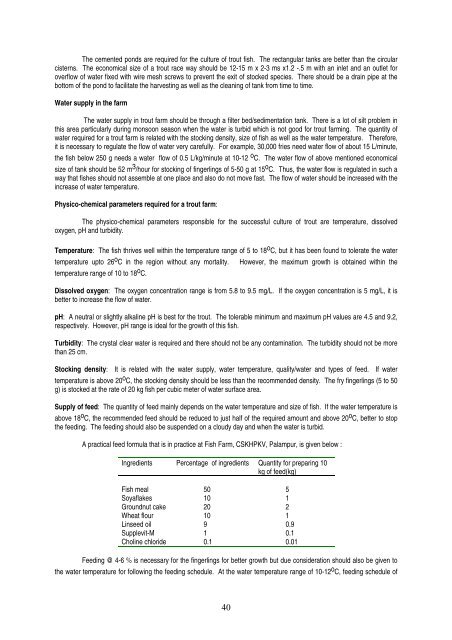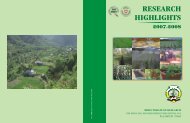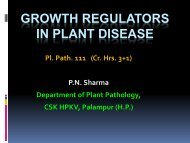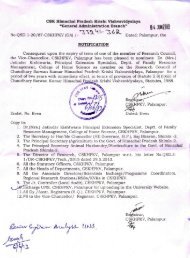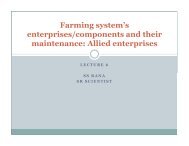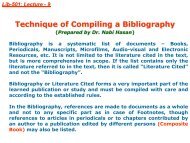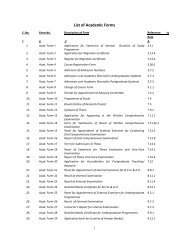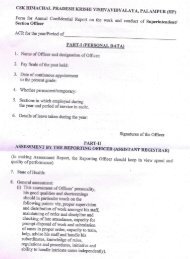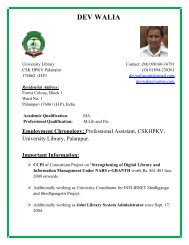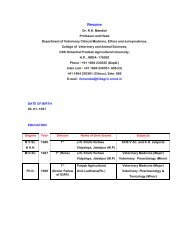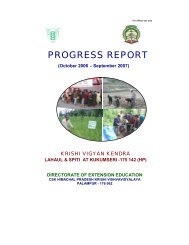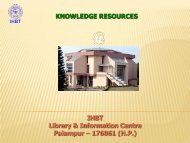animal production - CSK Himachal Pradesh Agricultural University ...
animal production - CSK Himachal Pradesh Agricultural University ...
animal production - CSK Himachal Pradesh Agricultural University ...
Create successful ePaper yourself
Turn your PDF publications into a flip-book with our unique Google optimized e-Paper software.
The cemented ponds are required for the culture of trout fish. The rectangular tanks are better than the circular<br />
cisterns. The economical size of a trout race way should be 12-15 m x 2-3 ms x1.2 -.5 m with an inlet and an outlet for<br />
overflow of water fixed with wire mesh screws to prevent the exit of stocked species. There should be a drain pipe at the<br />
bottom of the pond to facilitate the harvesting as well as the cleaning of tank from time to time.<br />
Water supply in the farm<br />
The water supply in trout farm should be through a filter bed/sedimentation tank. There is a lot of silt problem in<br />
this area particularly during monsoon season when the water is turbid which is not good for trout farming. The quantity of<br />
water required for a trout farm is related with the stocking density, size of fish as well as the water temperature. Therefore,<br />
it is necessary to regulate the flow of water very carefully. For example, 30,000 fries need water flow of about 15 L/minute,<br />
the fish below 250 g needs a water flow of 0.5 L/kg/minute at 10-12 oC. The water flow of above mentioned economical<br />
size of tank should be 52 m3 /hour for stocking of fingerlings of 5-50 g at 15oC. Thus, the water flow is regulated in such a<br />
way that fishes should not assemble at one place and also do not move fast. The flow of water should be increased with the<br />
increase of water temperature.<br />
Physico-chemical parameters required for a trout farm:<br />
The physico-chemical parameters responsible for the successful culture of trout are temperature, dissolved<br />
oxygen, pH and turbidity.<br />
Temperature: The fish thrives well within the temperature range of 5 to 18oC, but it has been found to tolerate the water<br />
temperature upto 26oC in the region without any mortality. However, the maximum growth is obtained within the<br />
temperature range of 10 to 18oC. Dissolved oxygen: The oxygen concentration range is from 5.8 to 9.5 mg/L. If the oxygen concentration is 5 mg/L, it is<br />
better to increase the flow of water.<br />
pH: A neutral or slightly alkaline pH is best for the trout. The tolerable minimum and maximum pH values are 4.5 and 9.2,<br />
respectively. However, pH range is ideal for the growth of this fish.<br />
Turbidity: The crystal clear water is required and there should not be any contamination. The turbidity should not be more<br />
than 25 cm.<br />
Stocking density: It is related with the water supply, water temperature, quality/water and types of feed. If water<br />
temperature is above 20oC, the stocking density should be less than the recommended density. The fry fingerlings (5 to 50<br />
g) is stocked at the rate of 20 kg fish per cubic meter of water surface area.<br />
Supply of feed: The quantity of feed mainly depends on the water temperature and size of fish. If the water temperature is<br />
above 18oC, the recommended feed should be reduced to just half of the required amount and above 20oC, better to stop<br />
the feeding. The feeding should also be suspended on a cloudy day and when the water is turbid.<br />
A practical feed formula that is in practice at Fish Farm, <strong>CSK</strong>HPKV, Palampur, is given below :<br />
Ingredients Percentage of ingredients Quantity for preparing 10<br />
kg of feed(kg)<br />
Fish meal 50 5<br />
Soyaflakes 10 1<br />
Groundnut cake 20 2<br />
Wheat flour 10 1<br />
Linseed oil 9 0.9<br />
Supplevit-M 1 0.1<br />
Choline chloride 0.1 0.01<br />
Feeding @ 4-6 % is necessary for the fingerlings for better growth but due consideration should also be given to<br />
the water temperature for following the feeding schedule. At the water temperature range of 10-12oC, feeding schedule of<br />
40


